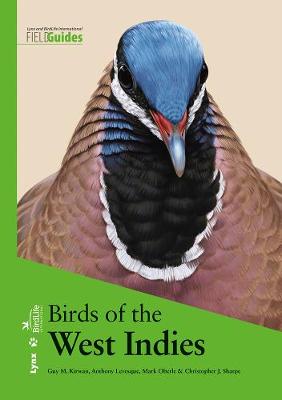Lynx and BirdLife International Field Guides Collection
1 total work
Birds of the West Indies
by Guy M. Kirwan, Anthony Levesque, Mark Oberle, and Christopher J. Sharpe
Published 10 June 2019
Most people associate the Caribbean with palm-fringed sandy beaches, cricket and rum. Mention the West Indies to birders and they think todies and tremblers, among a remarkable array of c. 190 endemic species. Furthermore, no fewer than six families are confined to the region, and another (spindalises) virtually so. The region also receives many vagrants from both North and South America, and even transatlantic arrivals from the Old World. If this were not sufficient enticement, several of the most poorly known and enigmatic birds in the world-including Ivory-billed Woodpecker and Semper's Warbler-as well as others requiring further taxonomic investigation, provide additional allure.
Taxonomy follows the HBW and BirdLife International Illustrated Checklist of the Birds of the World.
Detailed texts covering status, habitat and behaviour, age, sex and geographical variation, voice, and confusion species.
Over 1600 illustrations covering all species and distinctive subspecies, birds in flight, males and females, juveniles and non-breeding plumages, where appropriate.
QR code for each species, linking to the Internet Bird Collection gallery of photos, videos and sounds.
More than 650 full-colour range maps for all species other than vagrants.
Well-marked subspecies groups receive full accounts, and the distributions of subspecies breeding in the region are clearly mapped.
Features:
712 species; c. 190 endemics.
Over 1600 illustrations and more than 650 distribution maps.
Countries and territories covered in this guide:
Bahamas, Turks and Caicos Islands, Cuba, Cayman Islands, Jamaica, Haiti, Dominican Republic, Puerto Rico, Virgin Islands, Anguilla, Saint Martin, Saint Barthelemy, Saba, Sint Eustatius, Saint Kitts and Nevis, Antigua and Barbuda, Montserrat, Guadeloupe, Dominica, Martinique, Saint Lucia, Saint Vincent and the Grenadines, Grenada, Barbados, Isla de Aves, Swan Islands, San Andres, Providencia and Santa Catalina.
Taxonomy follows the HBW and BirdLife International Illustrated Checklist of the Birds of the World.
Detailed texts covering status, habitat and behaviour, age, sex and geographical variation, voice, and confusion species.
Over 1600 illustrations covering all species and distinctive subspecies, birds in flight, males and females, juveniles and non-breeding plumages, where appropriate.
QR code for each species, linking to the Internet Bird Collection gallery of photos, videos and sounds.
More than 650 full-colour range maps for all species other than vagrants.
Well-marked subspecies groups receive full accounts, and the distributions of subspecies breeding in the region are clearly mapped.
Features:
712 species; c. 190 endemics.
Over 1600 illustrations and more than 650 distribution maps.
Countries and territories covered in this guide:
Bahamas, Turks and Caicos Islands, Cuba, Cayman Islands, Jamaica, Haiti, Dominican Republic, Puerto Rico, Virgin Islands, Anguilla, Saint Martin, Saint Barthelemy, Saba, Sint Eustatius, Saint Kitts and Nevis, Antigua and Barbuda, Montserrat, Guadeloupe, Dominica, Martinique, Saint Lucia, Saint Vincent and the Grenadines, Grenada, Barbados, Isla de Aves, Swan Islands, San Andres, Providencia and Santa Catalina.
